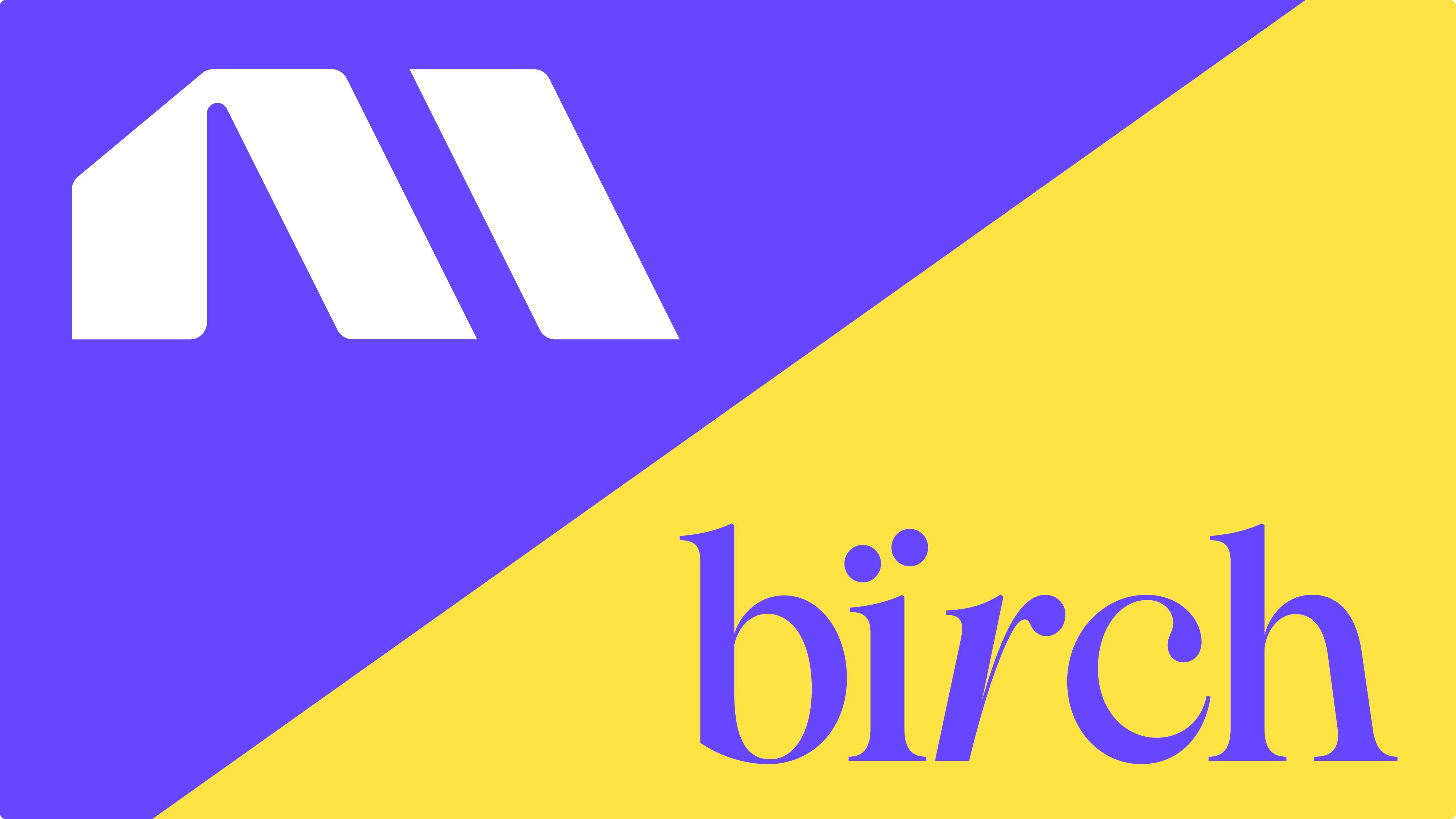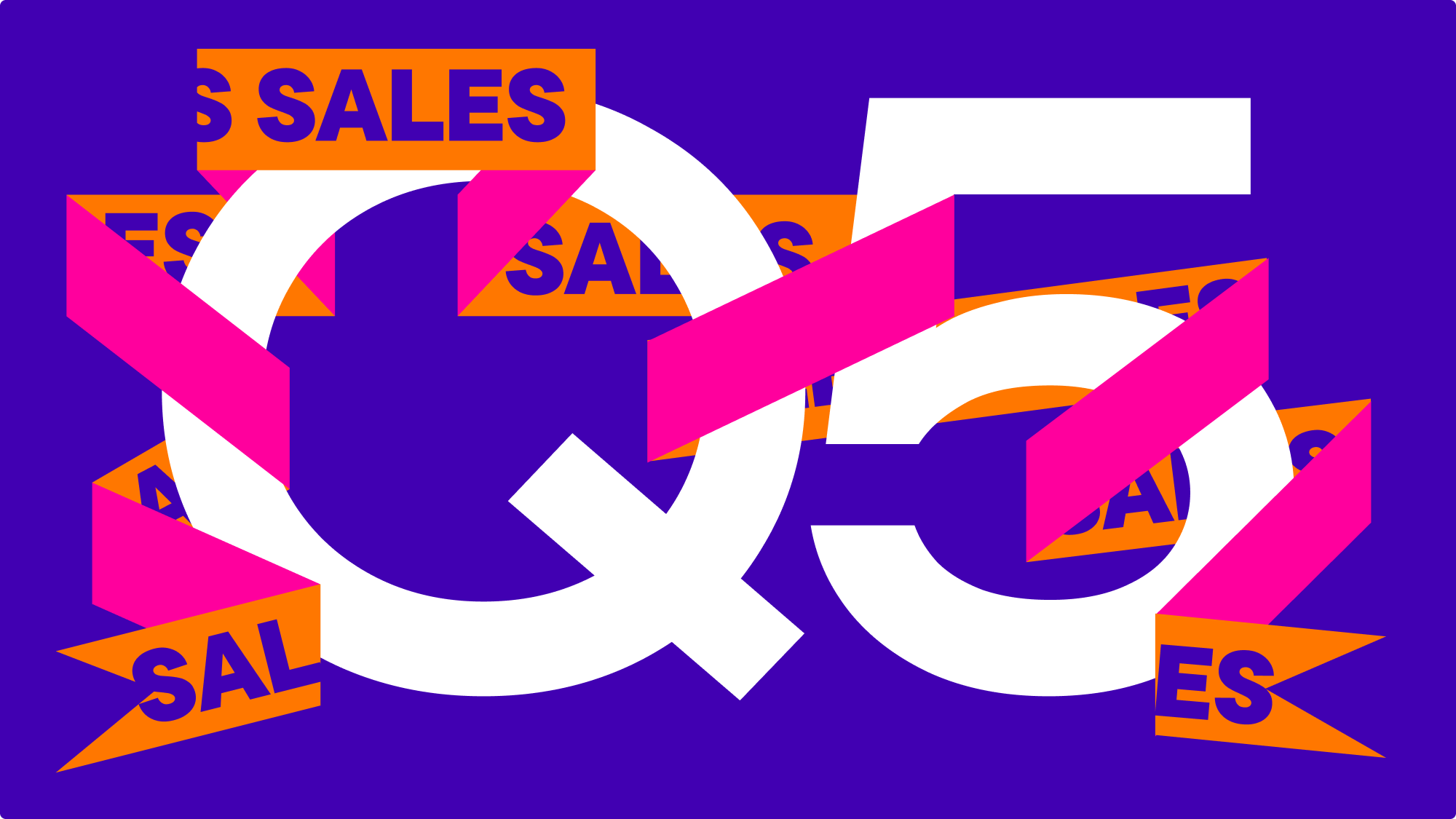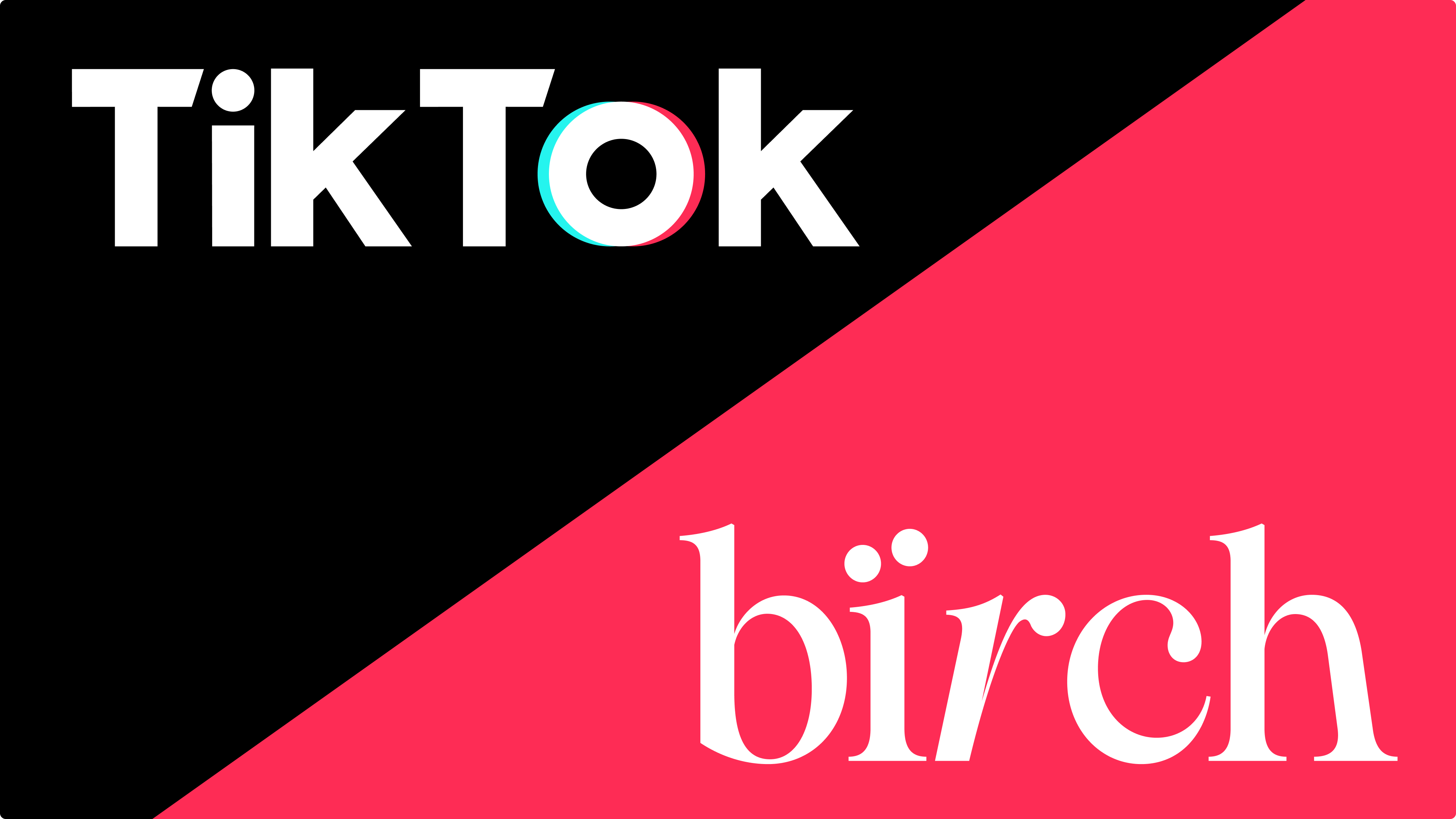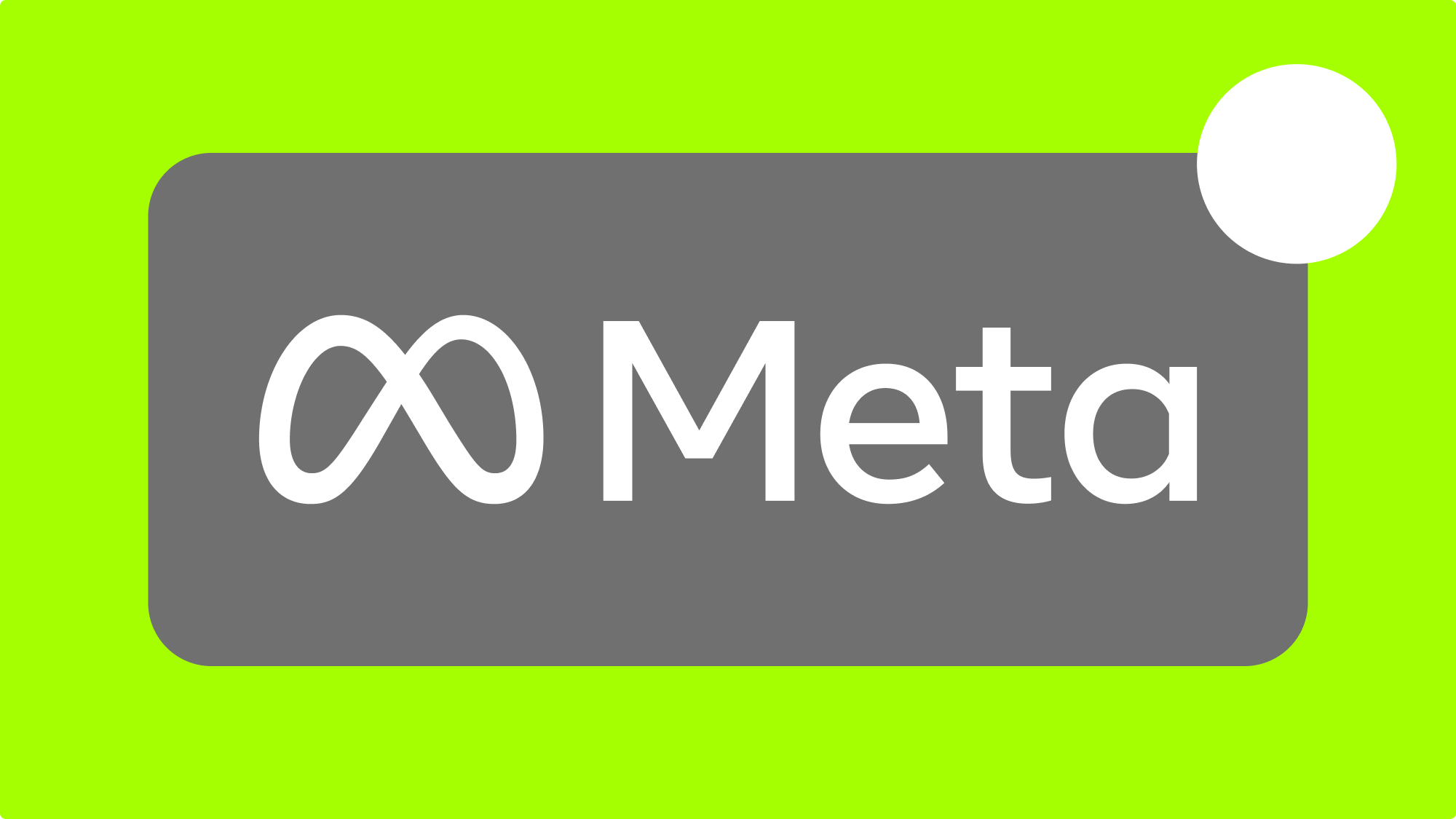Meta (Facebook) Ads optimization in 2026 is a whole different ballgame. You’re dealing with signal loss, aggressive automation, tighter attribution windows, and the platform pushing default setups that don’t always serve your goals.
Optimization still matters—more than ever—but the levers have shifted, and dated guides might not give you the results you want.
We’ve compiled this Meta Ads optimization guide for advanced performance marketers in 2026 who need to:
- Diagnose underperformance with clarity.
- Structure accounts for long-term scalability.
- Apply high-leverage optimization techniques like bidding strategies, creative testing, and automation rules that actually improve results.
Throughout, we’ll show how Bïrch helps make that system work—offering real-time alerts and automation, server-side tracking, and rapid testing infrastructure for teams who need to move fast without losing control.
Note: People still often say “Facebook Ads”, but this guide covers the full Meta Ads ecosystem—including Facebook, Instagram, Messenger, WhatsApp, and the Audience Network. To reflect that, we will use “Meta Ads” throughout the article.
Key takeaways:
- Optimization in 2026 is based on systems, not intuition: Winning accounts are structured, monitored, and iterated through real-time feedback loops.
- Meta automation is powerful… but not perfect: Pair Advantage+ campaigns, auto placements, and dynamic creatives with rules and overrides.
- Creative fatigue is the #1 performance killer: Proactive testing, decay curve tracking, and modular asset systems are essential for sustainable results.
- Signal quality drives scale: Implementing server-side tracking (CAPI), boosting event match quality (EMQ), and enriching audience data are key.
- Bid strategy still matters: Cost caps, ROAS targets, and manual floors can outpace automation when applied strategically.
- Diagnostics = resilience: Identifying what’s broken (or about to break) lets you react before the algorithm does. Daily and weekly checklists are key.
- Bïrch connects it all: From creative testing to Slack alerts, budget rules, and signal routing, Bïrch (formerly Revealbot) turns your optimization system into a performance engine.
Why Facebook ad optimization still matters in 2026
Things are changing: platform evolution, signal loss, automation shifts mean Meta Ads in 2026 look nothing like they did even two years ago.
Platform updates like Advantage+, changes in attribution windows, and increased reliance on modeled conversions have changed how performance marketers approach campaign optimization. But what’s driving the shift?
- Signal loss: Browser privacy changes, iOS updates, and global regulation have reduced the quality of event data. Server-side solutions like CAPI (Conversions API) are essential to keeping signals clean.
- Automation-first logic: Meta is pushing for simplified campaign setups and “hands-off” optimization—Advantage+ sales campaigns, dynamic creatives, and auto placements are now defaults.
- Fewer manual levers: More and more, Meta is hiding or simplifying granular controls. Manual bid strategies, audience overlaps, and placement exclusions are trickier to monitor and test.
Key optimization levers still in your control
Even with automation doing more of the heavy lifting, not everything is out of your hands. The best performance marketers know exactly where to lean in. These are the levers that still move the needle:
- Creative strategy
- Campaign structure
- Bidding and pacing
- Audience signals
- Attribution-aware feedback loops
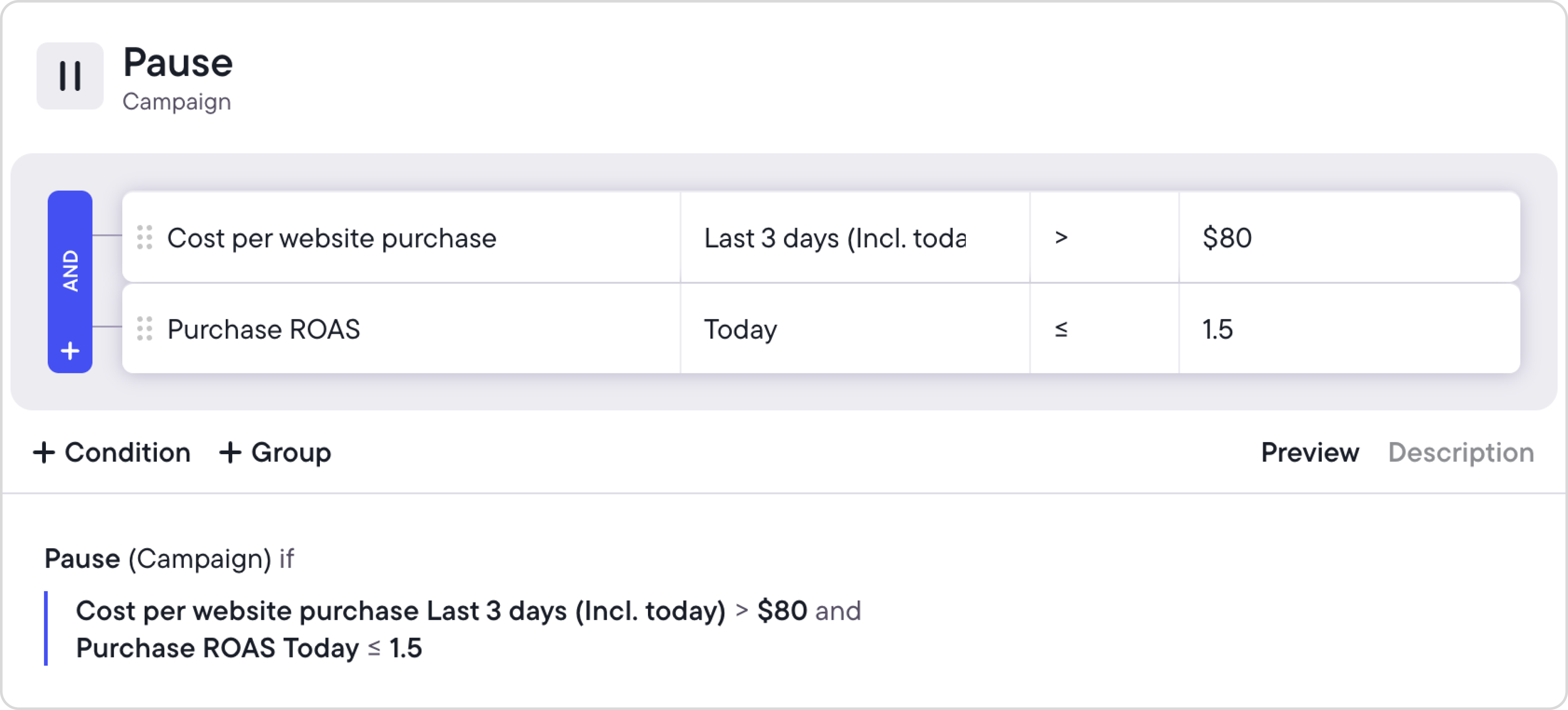
Use Bïrch’s automated rules to create conditions-based optimizations—for example, pause an ad set when CPA exceeds $80 for three days and ROAS falls below 1.5.
How to build a high-performance account structure
A poorly structured account creates noise in reporting, fragments learning phases, and restricts automation. A well-structured account, on the other hand, amplifies signals and consolidates data. Plus, it makes scaling easier.
Segmented campaign optimization vs. consolidated structure
Historically, marketers have split campaigns into granular segments—by audience, placement, or creative—to test variables. But Meta’s evolving algorithm often favors consolidation, especially within Advantage+ environments.
Segmented structure is useful when:
- You’re targeting distinct funnel stages (e.g., TOFU vs. BOFU)
- You have vastly different creatives or offers per segment
- Your product catalog spans diverse verticals
Consolidated structure is better when:
- You want to maximize learning efficiency and event density
- You’re optimizing with modeled or limited data (post-ATT)
- You rely heavily on automation (Advantage+ campaigns, CBO)
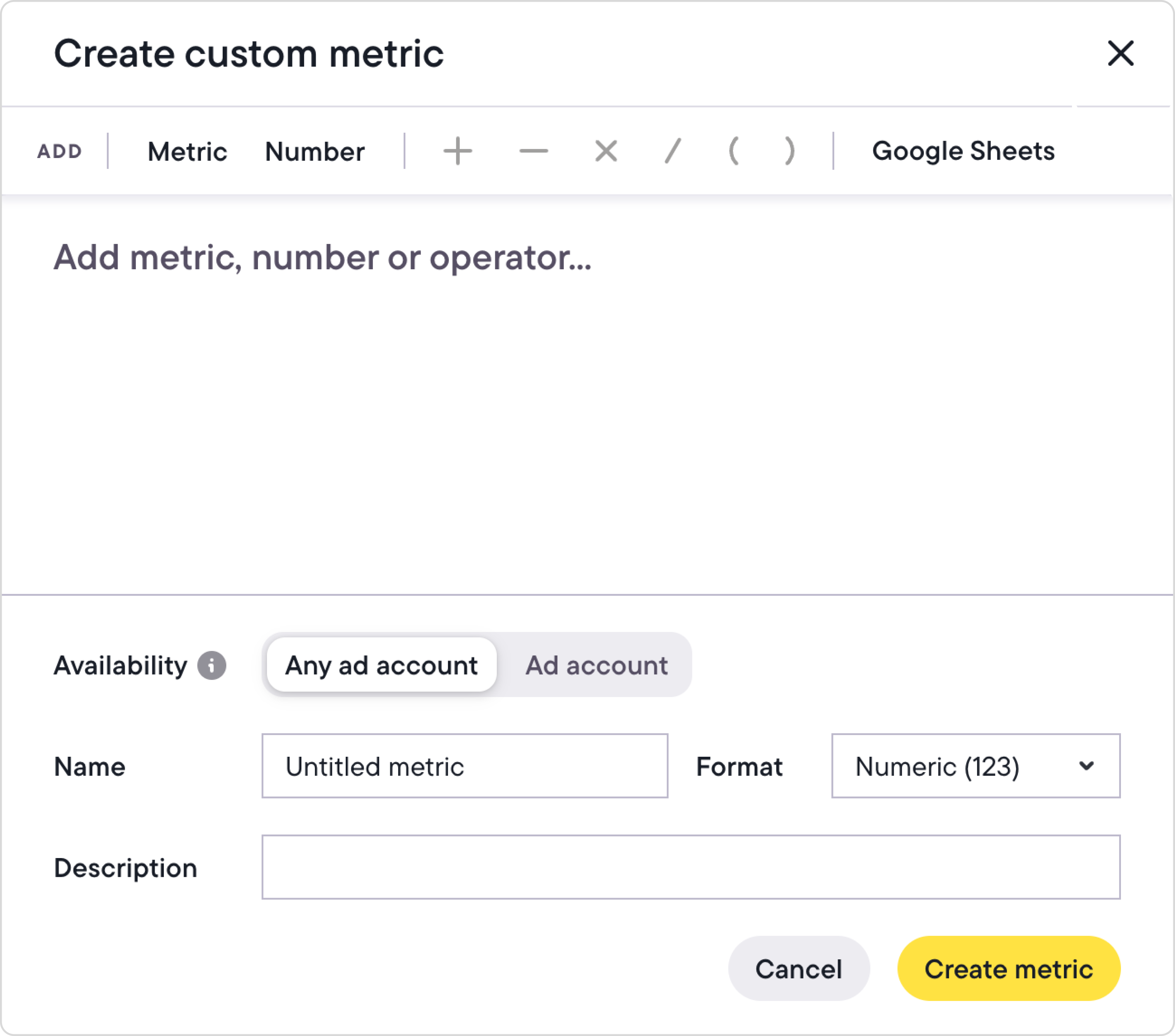
Use Bïrch to compare consolidated vs. segmented campaigns on key efficiency metrics like time-to-learning, event match quality, and ROAS volatility.
Manage campaigns across funnel stages with cross-channel input
Instead of thinking in terms of channels, try to view your campaigns as journeys. A well-optimized Meta account must reflect funnel logic informed by Google, TikTok, YouTube, and CRM data.
Structure your campaigns by intent tiers:
- Awareness: cold interest, broad targeting, content-first creatives
- Consideration: re-engagement, video viewers, lead magnets
- Conversion: cart abandoners, CRM reactivations, remarketing
Then, sync budgets and messaging across platforms. If TikTok drives awareness, Meta may be better suited to drive consideration and capture mid-funnel intent.
Use UTM signals and first-party data to sync audiences cross-channel. Bïrch’s Signals Gateway can help route those signals server-side into Meta.
Set up your account for signal strength
The algorithm can only optimize what it sees. That makes event quality and signal density key elements of any digital campaign optimization.
Try following these steps:
- Prioritize your pixel events based on actual funnel impact (not just legacy setups)
- Implement CAPI for every critical action—purchase, lead, subscription
- Boost EMQ by syncing email, phone, and click IDs server-side
- Use aggregated events with custom logic (e.g., composite “high-intent lead” signals)
Stronger signals make both Meta’s automation and your own rules work harder—and more predictably.
Choosing the right campaign objectives for intent-matching
In 2025, optimization for ad delivery begins the moment you choose your campaign objective. That choice determines how the algorithm interprets intent, finds audiences, and defines success.
Campaign objectives vs. ad delivery outcomes
Not all objectives are the same. While some optimize for clicks, others chase conversions or attention. If your chosen objective doesn’t match your desired business outcome, your ads will be optimized toward the wrong goal—even if you hit your KPIs.
Here’s a simple framework:
ODAX framework
Meta’s Outcome-Driven Ad Experiences (ODAX) simplifies objective selection but adds a layer of abstraction. ODAX groups campaigns into broader goals like “Sales” or “Leads”—but under the hood, delivery still hinges on your pixel and event quality.
For example:
- A “Sales” objective won’t optimize well without a strong “Purchase” signal.
- Choosing “Leads” may prioritize on-platform forms, even when external CRMs drive better performance.
Best practice in 2025? Match your ODAX objective with the cleanest downstream signal. If your CRM sends lead score data via CAPI, use that for real-time feedback loops.
See how Bïrch’s custom signals let you train campaigns on composite outcomes like “demo booked + positive survey response”.
When to break the rules using engagement for bottom-funnel ads
Some of the most effective personalized marketing campaign optimization strategies happen when you break the default logic… on purpose.
Here are some examples:
- Warm audiences may respond better to engagement-based retargeting ads (e.g., social proof) than direct conversion campaigns.
- Try building intent through storytelling for video views. This may outperform conversion objectives for high LTV products.
- Try a leads objective for closed-group webinars, especially if you use Meta forms plus Zapier to send data into your CRM.
Try to match your message and intent to the right optimization target. It’s not always about following the standard conversion path.
Advanced bidding and budgeting strategies
With Advantage+ campaign budget optimization (CBO) becoming more dominant and manual bidding options shrinking, bid optimization now requires sharper strategy and a mix of automation and overrides.
Bid optimization: manual bidding vs. cost cap/ROAS strategies
Meta now heavily favors automated bidding—but there’s still room for you to step in and take control. The key is choosing the right bidding method based on predictability and profitability.
Use spend-based bidding (highest volume or highest value) when:
- Your main goal is to spend your full budget and maximize volume.
- You’re flexible on CPA or ROAS and want to scale fast.
- You’re working with broader audiences and high-quality creative.
Use goal-based bidding (cost cap or ROAS goal) when:
- You want to keep your average CPA or ROAS within a specific range.
- You’re looking for balance between efficiency and volume.
- You can send accurate server-side signals (especially for ROAS goal).
Use manual bidding when:
- You need strict control over CPA or ROAS thresholds.
- You’re competing in volatile or expensive auction periods (e.g. Black Friday).
- You want to limit delivery deliberately for testing or pacing reasons.
Ad set budget optimization and when to override Advantage+
Meta’s Advantage+ features automatically shift budgets across ad sets and creatives. But… you might not always want that. Manual overrides sometimes give more control over message pacing and audience saturation.
When to override:
- When one creative outperforms but doesn’t get budget due to limited data
- When you want to cap spend on early-funnel audiences
- When Advantage+ over-prioritizes short-term ROAS at the expense of LTV
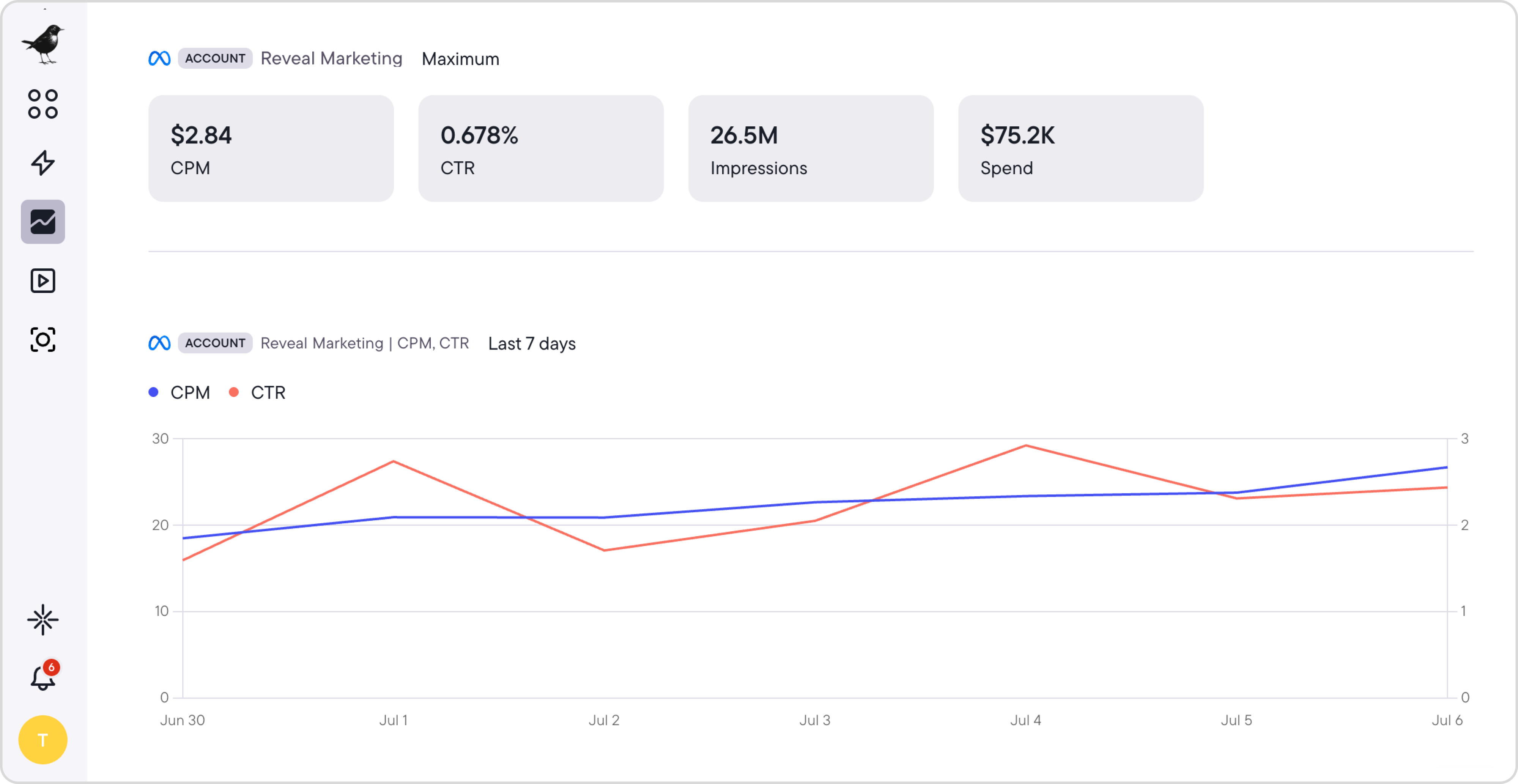
Use Bïrch to audit how automation distributes spend—and spot underfunded winners.
Campaign budget optimization vs. ad set budgets: scaling frameworks
When scaling, better to reflect your optimization goals:
- Use Advantage+ campaign budget for campaigns with homogeneous ad sets—same objective, intent level, and funnel stage
- Use Ad Set Budgets when testing new audiences or creatives independently
- For scaling, apply budget multipliers based on LTV, margin, or market size
Example framework:
- Tier 1 proven campaigns → scale Advantage+ campaign budget by 20–30% weekly
- Tier 2 test campaigns → run fixed-budget ad sets with tight caps
- Tier 3 retargeting or BOFU → use ROAS-based bid caps + time-based budget decay
Keep an eye on your budget elasticity (conversion volume vs. budget) each week. If it plateaus, it could be a sign that your campaign needs structural changes—not just a higher budget.
Creative testing & preventing fatigue
Creative remains the #1 lever for scalable, sustainable Meta Ad performance. In a platform built around attention and relevance, staying ahead of fatigue is key—which is why top advertisers bake creative testing into their process from the start.
Multivariate testing frameworks beyond A/B
In 2025, top performance marketing teams rely on multivariate creative testing—evaluating multiple variables (headline, format, CTA, visual style) simultaneously to uncover winning combinations that convert.
A modern testing stack might include:
- Format variations: static vs. video vs. carousel
- Messaging angles: emotional, rational, urgency, authority
- CTA phrasing: “Get Started” vs. “Try It Free” vs. “Watch Demo”
- Creative hooks: UGC-style, founder-led, product demo, lifestyle
How you might structure it:
- Use Advantage+ creative or dynamic creative ads sparingly (great for discovery, poor for scaling).
- Group variants by hypothesis—not at random.
- Apply strict rotation caps (e.g., max 3–4 active variants per ad set).
- Isolated variable testing: Test one element at a time per ad group to identify which factor truly drives performance.
- Consistent audience targeting: Always test creatives against the same audience to ensure performance differences come from the asset—not the audience.
- Single campaign per learning goal: Don’t test too many things at once—structure campaigns to learn one insight at a time (e.g., “What hook drives the highest CTR?”).
- Include a strong “champion” ad: Always benchmark new creatives against a proven performer to validate uplift.
- Rotate new creatives weekly or biweekly: Maintain freshness in learning and performance without exhausting the audience.
Using creative decay curves to rotate assets
Creative performance doesn’t drop off overnight—it declines gradually on a curve. Understanding that curve helps you plan rotations before results start to slip.
Indicators of creative fatigue:
- CTR drops while impressions remain steady
- CPM starts rising without increased competition
- ROAS declines despite consistent audience targeting
So, how can you combat creative fatigue? Plot decay curves using historical performance across asset types. Once you identify the typical lifespan (e.g., 7–10 days for static, 14–18 for UGC video), schedule proactive swaps or refreshes.

Avoid waiting for the algorithm to react. Instead, create rules with Bïrch’s automation that rotate creatives when fatigue thresholds are hit (e.g., CTR down 20% over three days).
Dynamic creatives vs. manual variants
Meta’s Dynamic Creative Ads automatically mix and match assets to find winning combinations. They’re powerful for testing, but limited for scaling.
In most cases, it’s a good idea to use Dynamic Creative Ads to identify themes and then spin out high-performing variants into manually optimized ad sets for better control and insights.
How to leverage Meta’s automation
While tools like Advantage+ campaigns and automatic placements simplify setup, relying on them too much can reduce control and transparency. The key is to embrace automation as a system component, letting it handle the execution while you stay in charge of the strategy.
How (and when) to use Advantage+ sales, creative and placements
Advantage+ sales campaigns (ASC) consolidate audience targeting, creative testing, and budget optimization into one campaign. They’re especially powerful for DTC brands with large SKUs and strong pixel data.
Best practices:
- Start with at least 10 creatives (ideally 3–4 formats and angles).
- Feed in broad audience signals (e.g., value-based LALs, recent purchasers).
- Set a minimum budget of ~$500/day to accelerate learning.
Advantage+ creative applies automatic enhancements like cropping, text overlays, and audio sync.
Best practices:
- Useful when you have minimal creative resources or you want speed over brand control
- Best to avoid when your brand identity is sensitive to formatting or you’re running highly polished, story-led campaigns
Advantage+ placements automatically distributes ads across Meta’s network to maximize efficiency, especially in awareness or scale campaigns.
Best practices:
- A great solution for awareness and scale campaigns
- If your product performs poorly in certain placements (e.g., Audience Network), a hybrid approach is better
Automation rules setup with Bïrch: examples for pausing and budget shifts
With Bïrch, you can build custom automation rules that respond to real-world performance shifts—so you’re not stuck waiting on weekly reports to make a move.
Useful rules to deploy:
- Pause underperforming ads: If CPA > $$$ for 3 consecutive days AND ROAS < XX, pause the ad.
- Dynamic budget shifting: Increase budget by XX% if ROAS > X.0 AND CTR > X%.
- Creative fatigue alerts: Get notified via Slack when CTR drops > XX% over XX hours.
Balancing automation with layered manual control
To avoid the trap of algorithm dependency, introduce layered manual control across key areas:
- Bidding floors: Keep manual bid caps to preserve ROAS floors during volatility.
- Budget ceilings: Prevent runaway spend from Advantage+ during low-quality traffic spikes.
- Creative locks: Manually rotate creatives even when performance appears stable (prevent slow-burn fatigue).
Let automation flag trends and problem areas, while you make the strategic calls to adjust and optimize.
Advanced audience strategy
Meta’s algorithm is getting better at finding buyers—but only if it starts with high-quality signals. That’s why the best performance marketers obsess over audience structure, exclusions, and enrichment.
Lookalikes vs. value-based lookalikes vs. modeled audiences
Classic lookalikes (LALs) remain effective—but in 2025, they’re no longer the most sophisticated option. Meta now offers several ways to create modeled audiences based on user behavior, purchase value, or LTV projections.
Stacking audiences (e.g., LAL + interest layer + device type) is still valid—but the highest leverage today comes from custom logic-driven modeling.
First-party data expansion via CAPI
In a privacy-first world, owning your own signal matters more than ever. Tapping into your own data using your CRM, email lists, app events, and product behavior is essential to Meta (Facebook) Ads optimization in 2025.
Here’s a quick checklist to enhance your Meta audience strategy:
- Implement CAPI for server-side events
- Sync email, phone, UTM, and click IDs
- Upload LTV lists regularly to build higher-quality lookalikes
- Track and score CRM leads for better exclusions or reactivation audiences
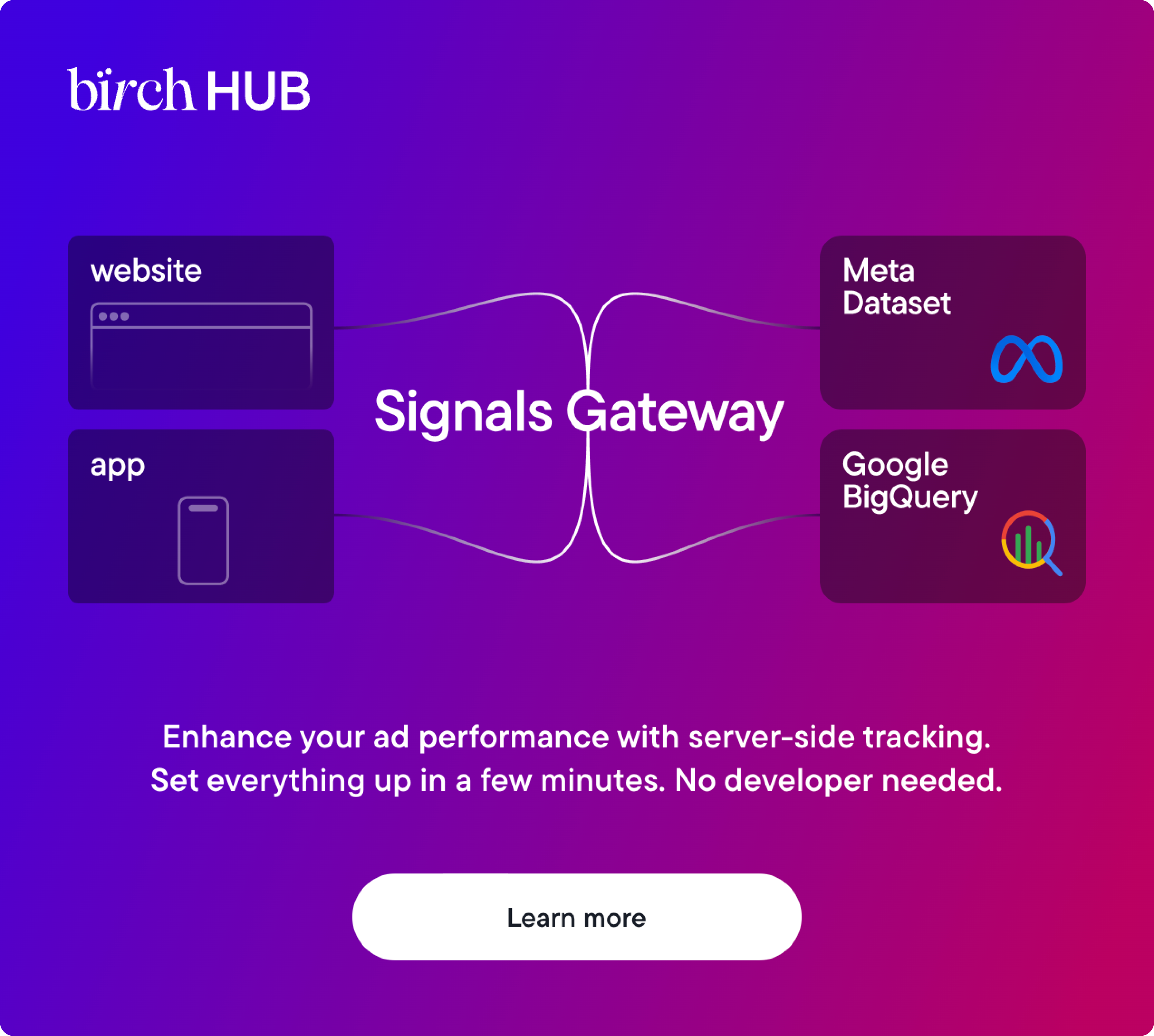
Use Bïrch’s Signals Gateway to automate signal enrichment and feed modeled audiences into Meta in real time.
Cross-channel signal enrichment and exclusions
Advanced marketers use cross-channel behavior to enrich or exclude users dynamically.
Here are some examples:
- Exclude users who just purchased via Google Search.
- Create retargeting pools for users who watched 75% of a YouTube video but didn’t convert.
- Use HubSpot scores to create “intent segments” for Meta delivery.
This approach prevents overlap, raises efficiency, and reduces CAC—especially when you’re scaling budgets or running cross-channel optimization.
You can also integrate Slack with Bïrch to get alerts when audience segments grow stale or when exclusions start underperforming.
Tracking, attribution, and diagnostics in a privacy-first era
The post-iOS14 world changed everything. Traditional tracking is fragmented, attribution windows have shrunk, and modeled conversions are now the default. But that doesn’t mean campaign optimization is guesswork—it just requires new thinking, smarter tools, and better signal management.
Post-ATT optimization using server-side tracking
Apple’s App Tracking Transparency (ATT) and similar global privacy shifts have weakened pixel-based tracking. Server-side methods like Conversions API (CAPI) are now essential for signal integrity.
These are our best practices in 2025:
- Always pair pixel with CAPI—this hybrid setup maximizes signal redundancy.
- Prioritize events like Purchase, Lead, and Subscribe using Aggregated Event Measurement (AEM).
- Send real-time values and LTV fields server-side to improve modeled data accuracy.
How to interpret modeled results in Ads Manager
As Meta increasingly uses modeled conversions, performance data is more of a probability model than a precise record.
Key principles:
- Don’t overreact to short-term dips—modeled data is smoothed over time.
- Use 7-day click + 1-day view attribution window when possible for more stable signals.
- Compare relative performance between ad sets, not just absolute numbers.
Build trend dashboards outside Meta (e.g., in Looker or Sheets) to normalize reporting and smooth out model noise.
Event match quality and its role in delivery
Event match quality is Meta’s score (0–10) for how well your event data identifies users. It directly impacts delivery. Better-matched events = more optimization power.
To improve EMQ:
- Pass more identifiers (email, phone, fbp/fbc, IP)
- Validate parameters via Meta’s Events Manager
- Avoid missing values or malformed fields in CAPI payloads
Audit your EMQ regularly. A two-to-three-point improvement can reduce CPMs and increase conversion rates—especially in performance-focused campaigns.
How to diagnose underperforming Meta Ad campaigns
When results drop, it’s rarely one clear culprit. Attribution lag, creative fatigue, audience decay, or automation drift can all look the same in-platform—but demand very different responses.
Advanced Meta Ads optimization starts with structured diagnosis. Before you react, isolate the variable, check your signals, and verify the system is working as expected.
Isolate variables
Here are some examples:
- ROAS drop, but CTR is stable? Likely an audience or conversion issue.
- CTR drops, but CPM is flat? Creative fatigue or misaligned messaging.
- CPM spikes with no change in targeting? Auction pressure or EMQ may be slipping.
- CPA rising, but conversion volume is constant? Attribution lag or shifting LTV dynamics.
Use diagnostic checkpoints across core areas
Create rules to detect underperformance early
Automation can help catch issues in real time:
- Slack alert: “Notify #ads if ROAS drops >XX0% week-over-week.”
- Budget shift rule: “Reduce spend by XX% if CTR < X% and CPA > $$$.”
- Creative flag: “Rotate asset if frequency > X and CTR falls for X consecutive days.”
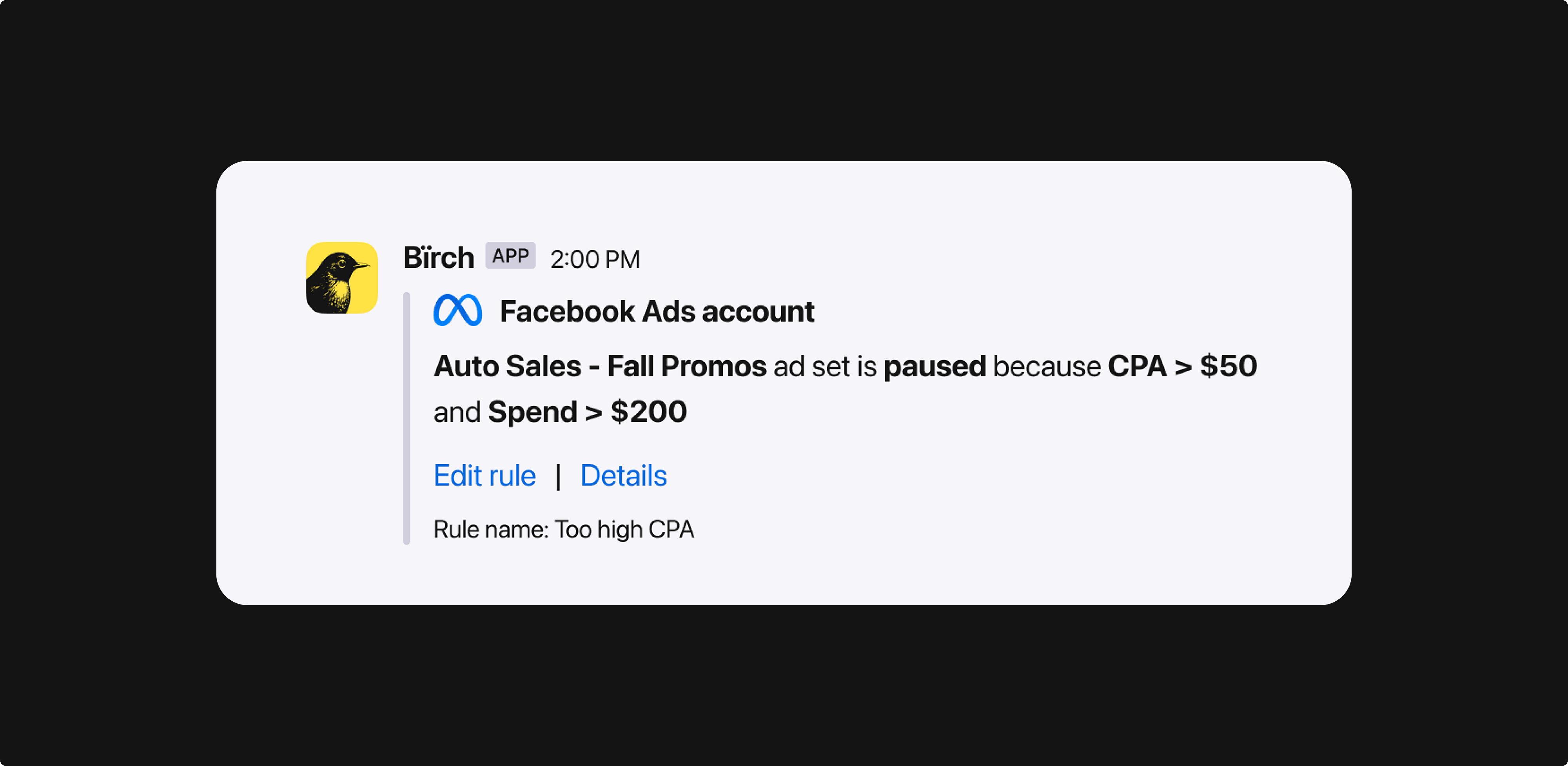
Set up alerts directly via Bïrch rules engine to create closed feedback loops that respond instantly.
Turn diagnostics into action
- Creative fatigue? → Swap hooks or reframe value props instead of reuploading.
- Signal issues? → Audit CAPI payloads and validate event parameters.
- Attribution noise? → Align reporting windows with funnel velocity (e.g., 7-day delay for lead gen).
Catching issues early makes a big difference when it comes to personalized marketing campaign optimization—especially when signals are noisy or attribution is delayed.
Real-world optimization loops
What drives high-performing Meta ad accounts isn’t automation alone, but consistent feedback loops that help teams spot issues, optimize, and scale with confidence.
In 2025, speed still matters, but consistency matters more. It’s about creating repeatable processes that make optimization part of your daily rhythm.
Weekly and daily performance checklists
You can run two types of reviews:
Daily checks (10–15 minutes):
- Is spend pacing correctly?
- Are any ad sets or creatives outside of KPI thresholds?
- Did any automation rules trigger?
- Are top creatives maintaining CTR?
Weekly deep-dives (1–2 hours):
- What’s working by funnel stage?
- Are our tests yielding statistically valid results?
- Are we hitting target CPA/ROAS across cohorts?
- What should be paused, scaled, or refreshed?
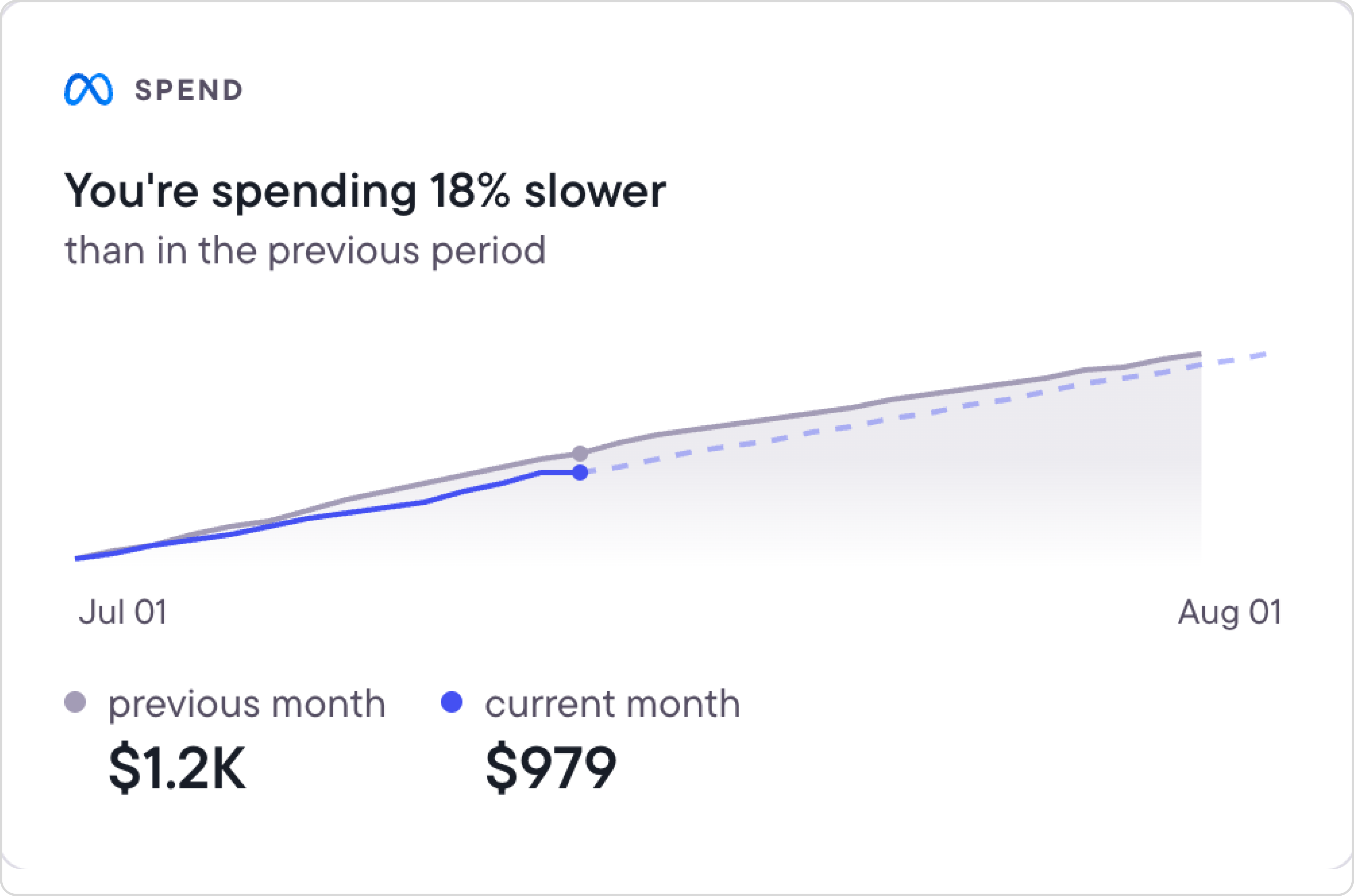
Use Bïrch’s reporting dashboards to auto-generate daily alerts and weekly summaries tailored to your account structure.
Attribution lag and when to trust the data
Attribution lag is real—and tougher to navigate with privacy changes and modeled data.
Suggested workaround strategies:
- Try not to over-optimize based on same-day data (especially in TOFU campaigns).
- Use delayed validation windows (e.g., check lead-to-sale conversion after 7–14 days).
- Mark “grace periods” in reports to avoid misleading short-term results.
Building alert systems via Bïrch + Slack
High-performing ad accounts move fast—and issues can spiral before you even open Ads Manager. That’s why Bïrch connects directly with Slack to keep your team in the loop.
Simply set up Slack alerts to monitor key shifts automatically. Here are some sample alert rules:
- Notify #ads when CPA rises > XX% for a key ad set
- Slack the team when a top creative’s CTR drops XX% week-over-week
- Combine alerts with “pause” or “budget reallocation” rules to create closed feedback loops.
Stay adaptive to stay ahead
By now, most teams know the days of set-and-forget Meta campaigns are long gone. In 2025, you need something that will give you an edge—a system that can adapt before things go off track.
This is where Bïrch helps—by automating routine tasks, sending smart alerts, and tying creative, bidding, and audience strategy directly to performance data. Bïrch is built for teams who want faster decisions, better visibility into ad performance, and fewer bottlenecks in their optimization process.
FAQs
What is Meta ad optimization?
Meta Ad optimization, also known as Facebook ad optimization, is the process of improving ad performance by adjusting campaign structure, targeting, bidding, creatives, and tracking. It aims to increase ROAS, lower CAC, and scale efficiently.
What is the best optimization strategy for Meta Ads?
There’s no one-size-fits-all answer—otherwise, we’d all be doing the same thing! However, we think the best strategies in 2025 involve:
- Using Advantage+ campaigns for broad learning
- Manually rotating creatives to fight fatigue
- Applying cost caps and bid rules dynamically
- Automating rules for pausing, scaling, and alerting
What is campaign optimization in digital marketing?
Campaign optimization means making continual adjustments to digital ad campaigns (budget, audience, creative, bidding) to improve their performance over time. It can span multiple platforms and includes both manual and automated processes.
How can I use bid optimization in Meta Ads Manager?
You can use Meta Ads Manager, previously known as Facebook Ads Manager, to:
- Set cost cap or ROAS bidding strategies
- Override Advantage+ with manual bid controls
- Monitor performance trends and apply rules to shift spend
For more advanced control, use Bïrch’s automated bidding rules to respond to CPA/ROAS changes in real time.
What happened to Revealbot?
Revealbot has a new look and a new name—we’re now Bïrch! The change highlights our focus on bringing together the best of automation and creative teamwork.
Meta (Facebook) Ads optimization in 2026 is a whole different ballgame. You’re dealing with signal loss, aggressive automation, tighter attribution windows, and the platform pushing default setups that don’t always serve your goals.
Optimization still matters—more than ever—but the levers have shifted, and dated guides might not give you the results you want.
We’ve compiled this Meta Ads optimization guide for advanced performance marketers in 2026 who need to:
- Diagnose underperformance with clarity.
- Structure accounts for long-term scalability.
- Apply high-leverage optimization techniques like bidding strategies, creative testing, and automation rules that actually improve results.
Throughout, we’ll show how Bïrch helps make that system work—offering real-time alerts and automation, server-side tracking, and rapid testing infrastructure for teams who need to move fast without losing control.
Note: People still often say “Facebook Ads”, but this guide covers the full Meta Ads ecosystem—including Facebook, Instagram, Messenger, WhatsApp, and the Audience Network. To reflect that, we will use “Meta Ads” throughout the article.
Key takeaways:
- Optimization in 2026 is based on systems, not intuition: Winning accounts are structured, monitored, and iterated through real-time feedback loops.
- Meta automation is powerful… but not perfect: Pair Advantage+ campaigns, auto placements, and dynamic creatives with rules and overrides.
- Creative fatigue is the #1 performance killer: Proactive testing, decay curve tracking, and modular asset systems are essential for sustainable results.
- Signal quality drives scale: Implementing server-side tracking (CAPI), boosting event match quality (EMQ), and enriching audience data are key.
- Bid strategy still matters: Cost caps, ROAS targets, and manual floors can outpace automation when applied strategically.
- Diagnostics = resilience: Identifying what’s broken (or about to break) lets you react before the algorithm does. Daily and weekly checklists are key.
- Bïrch connects it all: From creative testing to Slack alerts, budget rules, and signal routing, Bïrch (formerly Revealbot) turns your optimization system into a performance engine.
Why Facebook ad optimization still matters in 2026
Things are changing: platform evolution, signal loss, automation shifts mean Meta Ads in 2026 look nothing like they did even two years ago.
Platform updates like Advantage+, changes in attribution windows, and increased reliance on modeled conversions have changed how performance marketers approach campaign optimization. But what’s driving the shift?
- Signal loss: Browser privacy changes, iOS updates, and global regulation have reduced the quality of event data. Server-side solutions like CAPI (Conversions API) are essential to keeping signals clean.
- Automation-first logic: Meta is pushing for simplified campaign setups and “hands-off” optimization—Advantage+ sales campaigns, dynamic creatives, and auto placements are now defaults.
- Fewer manual levers: More and more, Meta is hiding or simplifying granular controls. Manual bid strategies, audience overlaps, and placement exclusions are trickier to monitor and test.
Key optimization levers still in your control
Even with automation doing more of the heavy lifting, not everything is out of your hands. The best performance marketers know exactly where to lean in. These are the levers that still move the needle:
- Creative strategy
- Campaign structure
- Bidding and pacing
- Audience signals
- Attribution-aware feedback loops

Use Bïrch’s automated rules to create conditions-based optimizations—for example, pause an ad set when CPA exceeds $80 for three days and ROAS falls below 1.5.
How to build a high-performance account structure
A poorly structured account creates noise in reporting, fragments learning phases, and restricts automation. A well-structured account, on the other hand, amplifies signals and consolidates data. Plus, it makes scaling easier.
Segmented campaign optimization vs. consolidated structure
Historically, marketers have split campaigns into granular segments—by audience, placement, or creative—to test variables. But Meta’s evolving algorithm often favors consolidation, especially within Advantage+ environments.
Segmented structure is useful when:
- You’re targeting distinct funnel stages (e.g., TOFU vs. BOFU)
- You have vastly different creatives or offers per segment
- Your product catalog spans diverse verticals
Consolidated structure is better when:
- You want to maximize learning efficiency and event density
- You’re optimizing with modeled or limited data (post-ATT)
- You rely heavily on automation (Advantage+ campaigns, CBO)

Use Bïrch to compare consolidated vs. segmented campaigns on key efficiency metrics like time-to-learning, event match quality, and ROAS volatility.
Manage campaigns across funnel stages with cross-channel input
Instead of thinking in terms of channels, try to view your campaigns as journeys. A well-optimized Meta account must reflect funnel logic informed by Google, TikTok, YouTube, and CRM data.
Structure your campaigns by intent tiers:
- Awareness: cold interest, broad targeting, content-first creatives
- Consideration: re-engagement, video viewers, lead magnets
- Conversion: cart abandoners, CRM reactivations, remarketing
Then, sync budgets and messaging across platforms. If TikTok drives awareness, Meta may be better suited to drive consideration and capture mid-funnel intent.
Use UTM signals and first-party data to sync audiences cross-channel. Bïrch’s Signals Gateway can help route those signals server-side into Meta.
Set up your account for signal strength
The algorithm can only optimize what it sees. That makes event quality and signal density key elements of any digital campaign optimization.
Try following these steps:
- Prioritize your pixel events based on actual funnel impact (not just legacy setups)
- Implement CAPI for every critical action—purchase, lead, subscription
- Boost EMQ by syncing email, phone, and click IDs server-side
- Use aggregated events with custom logic (e.g., composite “high-intent lead” signals)
Stronger signals make both Meta’s automation and your own rules work harder—and more predictably.
Choosing the right campaign objectives for intent-matching
In 2025, optimization for ad delivery begins the moment you choose your campaign objective. That choice determines how the algorithm interprets intent, finds audiences, and defines success.
Campaign objectives vs. ad delivery outcomes
Not all objectives are the same. While some optimize for clicks, others chase conversions or attention. If your chosen objective doesn’t match your desired business outcome, your ads will be optimized toward the wrong goal—even if you hit your KPIs.
Here’s a simple framework:
ODAX framework
Meta’s Outcome-Driven Ad Experiences (ODAX) simplifies objective selection but adds a layer of abstraction. ODAX groups campaigns into broader goals like “Sales” or “Leads”—but under the hood, delivery still hinges on your pixel and event quality.
For example:
- A “Sales” objective won’t optimize well without a strong “Purchase” signal.
- Choosing “Leads” may prioritize on-platform forms, even when external CRMs drive better performance.
Best practice in 2025? Match your ODAX objective with the cleanest downstream signal. If your CRM sends lead score data via CAPI, use that for real-time feedback loops.
See how Bïrch’s custom signals let you train campaigns on composite outcomes like “demo booked + positive survey response”.
When to break the rules using engagement for bottom-funnel ads
Some of the most effective personalized marketing campaign optimization strategies happen when you break the default logic… on purpose.
Here are some examples:
- Warm audiences may respond better to engagement-based retargeting ads (e.g., social proof) than direct conversion campaigns.
- Try building intent through storytelling for video views. This may outperform conversion objectives for high LTV products.
- Try a leads objective for closed-group webinars, especially if you use Meta forms plus Zapier to send data into your CRM.
Try to match your message and intent to the right optimization target. It’s not always about following the standard conversion path.
Advanced bidding and budgeting strategies
With Advantage+ campaign budget optimization (CBO) becoming more dominant and manual bidding options shrinking, bid optimization now requires sharper strategy and a mix of automation and overrides.
Bid optimization: manual bidding vs. cost cap/ROAS strategies
Meta now heavily favors automated bidding—but there’s still room for you to step in and take control. The key is choosing the right bidding method based on predictability and profitability.
Use spend-based bidding (highest volume or highest value) when:
- Your main goal is to spend your full budget and maximize volume.
- You’re flexible on CPA or ROAS and want to scale fast.
- You’re working with broader audiences and high-quality creative.
Use goal-based bidding (cost cap or ROAS goal) when:
- You want to keep your average CPA or ROAS within a specific range.
- You’re looking for balance between efficiency and volume.
- You can send accurate server-side signals (especially for ROAS goal).
Use manual bidding when:
- You need strict control over CPA or ROAS thresholds.
- You’re competing in volatile or expensive auction periods (e.g. Black Friday).
- You want to limit delivery deliberately for testing or pacing reasons.
Ad set budget optimization and when to override Advantage+
Meta’s Advantage+ features automatically shift budgets across ad sets and creatives. But… you might not always want that. Manual overrides sometimes give more control over message pacing and audience saturation.
When to override:
- When one creative outperforms but doesn’t get budget due to limited data
- When you want to cap spend on early-funnel audiences
- When Advantage+ over-prioritizes short-term ROAS at the expense of LTV

Use Bïrch to audit how automation distributes spend—and spot underfunded winners.
Campaign budget optimization vs. ad set budgets: scaling frameworks
When scaling, better to reflect your optimization goals:
- Use Advantage+ campaign budget for campaigns with homogeneous ad sets—same objective, intent level, and funnel stage
- Use Ad Set Budgets when testing new audiences or creatives independently
- For scaling, apply budget multipliers based on LTV, margin, or market size
Example framework:
- Tier 1 proven campaigns → scale Advantage+ campaign budget by 20–30% weekly
- Tier 2 test campaigns → run fixed-budget ad sets with tight caps
- Tier 3 retargeting or BOFU → use ROAS-based bid caps + time-based budget decay
Keep an eye on your budget elasticity (conversion volume vs. budget) each week. If it plateaus, it could be a sign that your campaign needs structural changes—not just a higher budget.
Creative testing & preventing fatigue
Creative remains the #1 lever for scalable, sustainable Meta Ad performance. In a platform built around attention and relevance, staying ahead of fatigue is key—which is why top advertisers bake creative testing into their process from the start.
Multivariate testing frameworks beyond A/B
In 2025, top performance marketing teams rely on multivariate creative testing—evaluating multiple variables (headline, format, CTA, visual style) simultaneously to uncover winning combinations that convert.
A modern testing stack might include:
- Format variations: static vs. video vs. carousel
- Messaging angles: emotional, rational, urgency, authority
- CTA phrasing: “Get Started” vs. “Try It Free” vs. “Watch Demo”
- Creative hooks: UGC-style, founder-led, product demo, lifestyle
How you might structure it:
- Use Advantage+ creative or dynamic creative ads sparingly (great for discovery, poor for scaling).
- Group variants by hypothesis—not at random.
- Apply strict rotation caps (e.g., max 3–4 active variants per ad set).
- Isolated variable testing: Test one element at a time per ad group to identify which factor truly drives performance.
- Consistent audience targeting: Always test creatives against the same audience to ensure performance differences come from the asset—not the audience.
- Single campaign per learning goal: Don’t test too many things at once—structure campaigns to learn one insight at a time (e.g., “What hook drives the highest CTR?”).
- Include a strong “champion” ad: Always benchmark new creatives against a proven performer to validate uplift.
- Rotate new creatives weekly or biweekly: Maintain freshness in learning and performance without exhausting the audience.
Using creative decay curves to rotate assets
Creative performance doesn’t drop off overnight—it declines gradually on a curve. Understanding that curve helps you plan rotations before results start to slip.
Indicators of creative fatigue:
- CTR drops while impressions remain steady
- CPM starts rising without increased competition
- ROAS declines despite consistent audience targeting
So, how can you combat creative fatigue? Plot decay curves using historical performance across asset types. Once you identify the typical lifespan (e.g., 7–10 days for static, 14–18 for UGC video), schedule proactive swaps or refreshes.

Avoid waiting for the algorithm to react. Instead, create rules with Bïrch’s automation that rotate creatives when fatigue thresholds are hit (e.g., CTR down 20% over three days).
Dynamic creatives vs. manual variants
Meta’s Dynamic Creative Ads automatically mix and match assets to find winning combinations. They’re powerful for testing, but limited for scaling.
In most cases, it’s a good idea to use Dynamic Creative Ads to identify themes and then spin out high-performing variants into manually optimized ad sets for better control and insights.
How to leverage Meta’s automation
While tools like Advantage+ campaigns and automatic placements simplify setup, relying on them too much can reduce control and transparency. The key is to embrace automation as a system component, letting it handle the execution while you stay in charge of the strategy.
How (and when) to use Advantage+ sales, creative and placements
Advantage+ sales campaigns (ASC) consolidate audience targeting, creative testing, and budget optimization into one campaign. They’re especially powerful for DTC brands with large SKUs and strong pixel data.
Best practices:
- Start with at least 10 creatives (ideally 3–4 formats and angles).
- Feed in broad audience signals (e.g., value-based LALs, recent purchasers).
- Set a minimum budget of ~$500/day to accelerate learning.
Advantage+ creative applies automatic enhancements like cropping, text overlays, and audio sync.
Best practices:
- Useful when you have minimal creative resources or you want speed over brand control
- Best to avoid when your brand identity is sensitive to formatting or you’re running highly polished, story-led campaigns
Advantage+ placements automatically distributes ads across Meta’s network to maximize efficiency, especially in awareness or scale campaigns.
Best practices:
- A great solution for awareness and scale campaigns
- If your product performs poorly in certain placements (e.g., Audience Network), a hybrid approach is better
Automation rules setup with Bïrch: examples for pausing and budget shifts
With Bïrch, you can build custom automation rules that respond to real-world performance shifts—so you’re not stuck waiting on weekly reports to make a move.
Useful rules to deploy:
- Pause underperforming ads: If CPA > $$$ for 3 consecutive days AND ROAS < XX, pause the ad.
- Dynamic budget shifting: Increase budget by XX% if ROAS > X.0 AND CTR > X%.
- Creative fatigue alerts: Get notified via Slack when CTR drops > XX% over XX hours.
Balancing automation with layered manual control
To avoid the trap of algorithm dependency, introduce layered manual control across key areas:
- Bidding floors: Keep manual bid caps to preserve ROAS floors during volatility.
- Budget ceilings: Prevent runaway spend from Advantage+ during low-quality traffic spikes.
- Creative locks: Manually rotate creatives even when performance appears stable (prevent slow-burn fatigue).
Let automation flag trends and problem areas, while you make the strategic calls to adjust and optimize.
Advanced audience strategy
Meta’s algorithm is getting better at finding buyers—but only if it starts with high-quality signals. That’s why the best performance marketers obsess over audience structure, exclusions, and enrichment.
Lookalikes vs. value-based lookalikes vs. modeled audiences
Classic lookalikes (LALs) remain effective—but in 2025, they’re no longer the most sophisticated option. Meta now offers several ways to create modeled audiences based on user behavior, purchase value, or LTV projections.
Stacking audiences (e.g., LAL + interest layer + device type) is still valid—but the highest leverage today comes from custom logic-driven modeling.
First-party data expansion via CAPI
In a privacy-first world, owning your own signal matters more than ever. Tapping into your own data using your CRM, email lists, app events, and product behavior is essential to Meta (Facebook) Ads optimization in 2025.
Here’s a quick checklist to enhance your Meta audience strategy:
- Implement CAPI for server-side events
- Sync email, phone, UTM, and click IDs
- Upload LTV lists regularly to build higher-quality lookalikes
- Track and score CRM leads for better exclusions or reactivation audiences

Use Bïrch’s Signals Gateway to automate signal enrichment and feed modeled audiences into Meta in real time.
Cross-channel signal enrichment and exclusions
Advanced marketers use cross-channel behavior to enrich or exclude users dynamically.
Here are some examples:
- Exclude users who just purchased via Google Search.
- Create retargeting pools for users who watched 75% of a YouTube video but didn’t convert.
- Use HubSpot scores to create “intent segments” for Meta delivery.
This approach prevents overlap, raises efficiency, and reduces CAC—especially when you’re scaling budgets or running cross-channel optimization.
You can also integrate Slack with Bïrch to get alerts when audience segments grow stale or when exclusions start underperforming.
Tracking, attribution, and diagnostics in a privacy-first era
The post-iOS14 world changed everything. Traditional tracking is fragmented, attribution windows have shrunk, and modeled conversions are now the default. But that doesn’t mean campaign optimization is guesswork—it just requires new thinking, smarter tools, and better signal management.
Post-ATT optimization using server-side tracking
Apple’s App Tracking Transparency (ATT) and similar global privacy shifts have weakened pixel-based tracking. Server-side methods like Conversions API (CAPI) are now essential for signal integrity.
These are our best practices in 2025:
- Always pair pixel with CAPI—this hybrid setup maximizes signal redundancy.
- Prioritize events like Purchase, Lead, and Subscribe using Aggregated Event Measurement (AEM).
- Send real-time values and LTV fields server-side to improve modeled data accuracy.
How to interpret modeled results in Ads Manager
As Meta increasingly uses modeled conversions, performance data is more of a probability model than a precise record.
Key principles:
- Don’t overreact to short-term dips—modeled data is smoothed over time.
- Use 7-day click + 1-day view attribution window when possible for more stable signals.
- Compare relative performance between ad sets, not just absolute numbers.
Build trend dashboards outside Meta (e.g., in Looker or Sheets) to normalize reporting and smooth out model noise.
Event match quality and its role in delivery
Event match quality is Meta’s score (0–10) for how well your event data identifies users. It directly impacts delivery. Better-matched events = more optimization power.
To improve EMQ:
- Pass more identifiers (email, phone, fbp/fbc, IP)
- Validate parameters via Meta’s Events Manager
- Avoid missing values or malformed fields in CAPI payloads
Audit your EMQ regularly. A two-to-three-point improvement can reduce CPMs and increase conversion rates—especially in performance-focused campaigns.
How to diagnose underperforming Meta Ad campaigns
When results drop, it’s rarely one clear culprit. Attribution lag, creative fatigue, audience decay, or automation drift can all look the same in-platform—but demand very different responses.
Advanced Meta Ads optimization starts with structured diagnosis. Before you react, isolate the variable, check your signals, and verify the system is working as expected.
Isolate variables
Here are some examples:
- ROAS drop, but CTR is stable? Likely an audience or conversion issue.
- CTR drops, but CPM is flat? Creative fatigue or misaligned messaging.
- CPM spikes with no change in targeting? Auction pressure or EMQ may be slipping.
- CPA rising, but conversion volume is constant? Attribution lag or shifting LTV dynamics.
Use diagnostic checkpoints across core areas
Create rules to detect underperformance early
Automation can help catch issues in real time:
- Slack alert: “Notify #ads if ROAS drops >XX0% week-over-week.”
- Budget shift rule: “Reduce spend by XX% if CTR < X% and CPA > $$$.”
- Creative flag: “Rotate asset if frequency > X and CTR falls for X consecutive days.”

Set up alerts directly via Bïrch rules engine to create closed feedback loops that respond instantly.
Turn diagnostics into action
- Creative fatigue? → Swap hooks or reframe value props instead of reuploading.
- Signal issues? → Audit CAPI payloads and validate event parameters.
- Attribution noise? → Align reporting windows with funnel velocity (e.g., 7-day delay for lead gen).
Catching issues early makes a big difference when it comes to personalized marketing campaign optimization—especially when signals are noisy or attribution is delayed.
Real-world optimization loops
What drives high-performing Meta ad accounts isn’t automation alone, but consistent feedback loops that help teams spot issues, optimize, and scale with confidence.
In 2025, speed still matters, but consistency matters more. It’s about creating repeatable processes that make optimization part of your daily rhythm.
Weekly and daily performance checklists
You can run two types of reviews:
Daily checks (10–15 minutes):
- Is spend pacing correctly?
- Are any ad sets or creatives outside of KPI thresholds?
- Did any automation rules trigger?
- Are top creatives maintaining CTR?
Weekly deep-dives (1–2 hours):
- What’s working by funnel stage?
- Are our tests yielding statistically valid results?
- Are we hitting target CPA/ROAS across cohorts?
- What should be paused, scaled, or refreshed?

Use Bïrch’s reporting dashboards to auto-generate daily alerts and weekly summaries tailored to your account structure.
Attribution lag and when to trust the data
Attribution lag is real—and tougher to navigate with privacy changes and modeled data.
Suggested workaround strategies:
- Try not to over-optimize based on same-day data (especially in TOFU campaigns).
- Use delayed validation windows (e.g., check lead-to-sale conversion after 7–14 days).
- Mark “grace periods” in reports to avoid misleading short-term results.
Building alert systems via Bïrch + Slack
High-performing ad accounts move fast—and issues can spiral before you even open Ads Manager. That’s why Bïrch connects directly with Slack to keep your team in the loop.
Simply set up Slack alerts to monitor key shifts automatically. Here are some sample alert rules:
- Notify #ads when CPA rises > XX% for a key ad set
- Slack the team when a top creative’s CTR drops XX% week-over-week
- Combine alerts with “pause” or “budget reallocation” rules to create closed feedback loops.
Stay adaptive to stay ahead
By now, most teams know the days of set-and-forget Meta campaigns are long gone. In 2025, you need something that will give you an edge—a system that can adapt before things go off track.
This is where Bïrch helps—by automating routine tasks, sending smart alerts, and tying creative, bidding, and audience strategy directly to performance data. Bïrch is built for teams who want faster decisions, better visibility into ad performance, and fewer bottlenecks in their optimization process.
FAQs
What is Meta ad optimization?
Meta Ad optimization, also known as Facebook ad optimization, is the process of improving ad performance by adjusting campaign structure, targeting, bidding, creatives, and tracking. It aims to increase ROAS, lower CAC, and scale efficiently.
What is the best optimization strategy for Meta Ads?
There’s no one-size-fits-all answer—otherwise, we’d all be doing the same thing! However, we think the best strategies in 2025 involve:
- Using Advantage+ campaigns for broad learning
- Manually rotating creatives to fight fatigue
- Applying cost caps and bid rules dynamically
- Automating rules for pausing, scaling, and alerting
What is campaign optimization in digital marketing?
Campaign optimization means making continual adjustments to digital ad campaigns (budget, audience, creative, bidding) to improve their performance over time. It can span multiple platforms and includes both manual and automated processes.
How can I use bid optimization in Meta Ads Manager?
You can use Meta Ads Manager, previously known as Facebook Ads Manager, to:
- Set cost cap or ROAS bidding strategies
- Override Advantage+ with manual bid controls
- Monitor performance trends and apply rules to shift spend
For more advanced control, use Bïrch’s automated bidding rules to respond to CPA/ROAS changes in real time.
What happened to Revealbot?
Revealbot has a new look and a new name—we’re now Bïrch! The change highlights our focus on bringing together the best of automation and creative teamwork.













